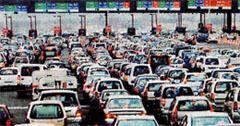Reliance Infra bags Rs 590crore Jaipur project
October 26, 2009
New Delhi: Reliance Infrastructure, the Anil Dhirubhai Ambani Group (ADAG) company, has won the Rs 590 crore Jaipur-Reengus highway project in Rajasthan from the National Highways Authority of India (NHAI).
The project is expected to be completed by 2011.
The company is currently implementing road projects worth Rs 4,500 crore and aims to increase its road portfolio more than four-fold to over Rs 20,000 crore by 2012.
Reliance Infra bagged the Rajasthan project on the basis of the lowest quote for grant at Rs 103 crore. The upgrade work of the 53 kilometre stretch will be implemented on a build operate and transfer (BOT) basis for a concession period of 18 years, including the construction period. After completion of the project, the company will earn toll through the remaining period before handing over the project to NHAI.
“Jaipur-Reengus contract is the seventh road project won by Reliance Infrastructure. With this, the company would be committing more than Rs 4,500 crore for the road sector. We are planning to increase the total road project portfolio over Rs 20,000 crore by 2012-13,” Lalit Jalan, CEO, Reliance Infrastructure, said in a statement.
The deal is likely to be signed in a month and the construction will begin soon thereafter. The group has a market capitalisation of around Rs 1,50,000 crore, and net worth of over Rs 64,000 crore. Also, the operating cash with the group is to the tune of Rs 13,000 crore.
The company’s two Tamil Nadu projects became operational last week. The projects, Namakkal-Karur and Dindigul-Samynalore, are worth Rs 763 crore and span 96 kilometres.All the remaining road projects are expected to be operational by March 2011.
Also, Reliance Infra is bullish on the infrastructure growth in the country.”Infrastructure will be a major source of revenue for us and we will bid for most of the projects being planned in the country,” Jalan said.
It is undergoing the tendering process in projects worth around Rs 50,000 crore. The company has achieved financial closure for the Rs 2,356 crore first phase of Mumbai Metro project and has also bagged the Rs 11,000 crore second phase of the project to develop a 32 kilometre stretch for a concession period of 35 years.
Source: dnaindia.com
UPA-2 road plans hit a bump
October 26, 2009
NEW DELHI: This could be an indicator of how the ambitious highway development programme has been a non-starter in UPA-2. National Highways
Authority of India (NHAI) has awarded only 17 projects for 1,574 km since January against the plan of awarding 135 projects (14,384 km) in the current financial.
A presentation made by the highway regulator at a CII conference on consulting services on Tuesday pointed to the huge gap between the projection and actual pace of award of projects in the past 10 months. As per the presentation, only 17 projects costing Rs 17,757 crore were awarded including one project on BOT (annuity). It further showed that nine more projects on BOT (toll) and two on annuity modes were under the process of award. However, information was not available on how many highway projects were awarded since the change of guard in the ministry.
NHAI officials blamed the slow pace on certain “controversial clauses” and provisions in the request for quotation (RFQ) and request for proposal (RFP) and the model concession agreement. “We had prepared a plan to award 60 projects last year but the economic downturn hit us hard and only 12-13 projects could be awarded. Many projects could not achieve financial closure even after awarding. This time it’s equally worse due to certain contractual provisions and clauses of the bid documents including the conflict of interest clause,” said a senior official.
Road, transport and highways minister Kamal Nath has already identified the interpretation of ‘conflict of interest’ as the biggest roadblock in the fast tracking of highway projects.
Transport secretary Brahm Dutt admitted on Tuesday that the award of projects was taking time while the ministry had set a target of achieving construction of 20 km highway per day.
Source: timesofindia.indiatimes.com
Government moves towards open toll system for highways
October 22, 2009
Highway users, there is good news round the corner. Soon, you will not have to stop for payment at every toll plaza.
The government is on the verge of introducing an open road tolling (ORT) system in the country, by which toll payment would become a one-time transaction per trip. 
The toll fees will be deducted either from the users’ bank account, or it collected at the beginning of the journey, in the manner of pre-paid or post-paid phone connections.
The ministry of road, transport and highways (MoRTH) will on October 31 start a six-month pilot project to test the efficacy of ORT on three stretches on the national highways.
Three systems of ORT — Active, Passive and Calm tolling systems — would be tested for suitability.
The active tolling system (a microwave tag-based system that sends or receives signals) will be tested on the Gurgaon-
Jaipur stretch. The passive system (also microwave-based, but only send signals) on the Panipat-Jalandhar stretch. The calm ORT system, an infrared-based system that sends and receives signals and works on an optical fibre network, will be tried on the Surat-Dasihar stretch.
“We will finalise a system that is best suited for India. The tests have to be very elaborate and that is why they will carry on for six months,” a senior official at the ministry, who did not wish to be named as he is not authorised to speak to the media, told Hindustan Times.
A third party will independently evaluate the three systems for suitability for use in India.
The new toll system will significantly reduce the time spent by commercial vehicles at tollbooths. For instance, a commercial vehicle plying between Delhi and Mumbai has to stop at 20 toll plazas.
On an average, there is a toll plaza every 60 km in India.
“It will be a very good thing. Separate lanes for the new toll system will result in significant saving of travel time,” said Anil K.G., resident consultant of Bangalore-based logistics company Transworld International, which runs a fleet of 150 trucks.
Source: hindustantimes.com
Interview with Mr. Allan Le Roux
October 8, 2009

Mr. Allan Le Roux is one of the most experienced Tolling Engineers in the area of Toll Plaza Design, Equipment Design and Toll Operations in India. He has 20 years experience in Tolling 12 years in his native South Africa and more than 7 years in India; having successfully implemented more than 80 lanes in India.
ITW: Thank you very much for sparing the time for this Interview
ALR: It is a pleasure
ITW: How do you think the Indian road user has taken to the tolling now that it is almost 5-6 years since tolling has been common for the Indian road user?
ALR: Yes I have noticed a few positive items; the motorists are now more willing to pay for a good road and good service than a few years ago. The service delivery is however important and the operator does on occasion create a problem that creates some irritation factor. The operations staff should be trained to deal with the problems and resolve them amicably and in as short a time as possible. The two person collection method per lane that has been adopted on may projects has also started to reduce this streamlines the cash collection process and makes the processing of vehicle quicker.
ITW: What are the biggest challenges that the Concessionaire faces for operating in India and what are the important changes in the Legislature required to make the Tolling operation easier for the Concessionaire.
ALR: That is a difficult question to answer! I think that this does not only apply to Concessionaires in India but around the world, I feel greatest challenge for the Concessionaire is to finish the construction period on time. For every month saved on construction the revenue generated at the Toll Plaza is significant. This revenue is lost for every day that the project exceeds the allocated construction period. There are many problems but I think this is the biggest problem. The second biggest challenge is to improve on the quality of the workmanship on all fronts; this saves a huge amount of money in ongoing routine road maintenance costs. By delaying an overlay for 12-14 months can be very profitable for the concessionaire.
ITW: Do you think projects like Delhi-Gurgaon will eventually go the Free flow way?
ALR: As part of the team that assisted in the development of the Delhi Gurgaon Expressway I think that with the significant traffic that is processed in the toll plaza the option to open a Limited Free Flow option will eventually become a reality. The following problems however exist, Driver attitude to Free Flow may result in the Free Flow lanes becoming “free”.
Enforcement and charging of these “violators” will be mandatory with the “fee” being significantly more than the current toll fee, MCD introduced a charging of 10 times the fee for commercial vehicles that failed to pay the required MCD Commercial Entry Tax and this was a serious deterrent. Legislation would however need to be passed t ensure the Concessionaire can enforce this.
Additional Fees charged for all motorists paying cash in the Non-Stop lanes would also go a long way to reducing the frustration of vehicles fitted with On Board Units. Congestion Charging may also be a solution to be considered.
ITW: Does installation of HTMS field equipments make the expressways safer and ensures smoother operation?
ALR: Yes, some of the HTMS items do add value to any road. HTMS items are numerous, some of them can add a significant benefit to the motorist, the use of Variable Message Systems posted at strategic location on any project can provide important information to the motorists, and Video Incident Detection Systems (VIDS) also assist in the management of incidents. Weather stations can provide information to the control room which can be placed on the VMS to indicate fog, ice, heavy rain etc. The installation of ECB along the entire corridor is probably the least used item, the introduction of the mobile phone has seen to the usage of the ECB declining significantly, in a survey that was conducted it was noted that 98% of all vehicles passing through a particular plaza have a mobile phone, some more than one!! These items are also vandalized for the battery and associated electronics on a regular basis.
ITW: How do you feel to deal with issues like violation of lanes? Should Authoritative power should be given to concessionaires to stop the motorists slipping away.
ALR: I think that not providing the Concessionaire the right to collect and fine the violator is an important step in reducing this type of driver behavior, I think that this should be provided for every Concession Contract.
ITW: Do you think the Indian tolling Industry is open to adopt latest technologies?
ALR: Yes in a limited manner. There is no doubt that good equipment can reduce the loss of revenue in the lane is a fact. That all the Concessionaires are realizing this is another question, yes some of the Concessionaire see the long term value of this and invest in it, technology is however not cheap.
ITW: What has been your negative and positive experience, as far as project implementation in India is concerned?
ALR: Negative experiences, very very few, positive!! Many, being part of the Tolling Industry has been good for me, being a part of Asia’s biggest toll plaza was fantastic. Ongoing development of world class systems, world class toll plazas is also a positive experience for me. And Contributing to the huge positive growth in India has really I think being fantastic for me on a personal front.






